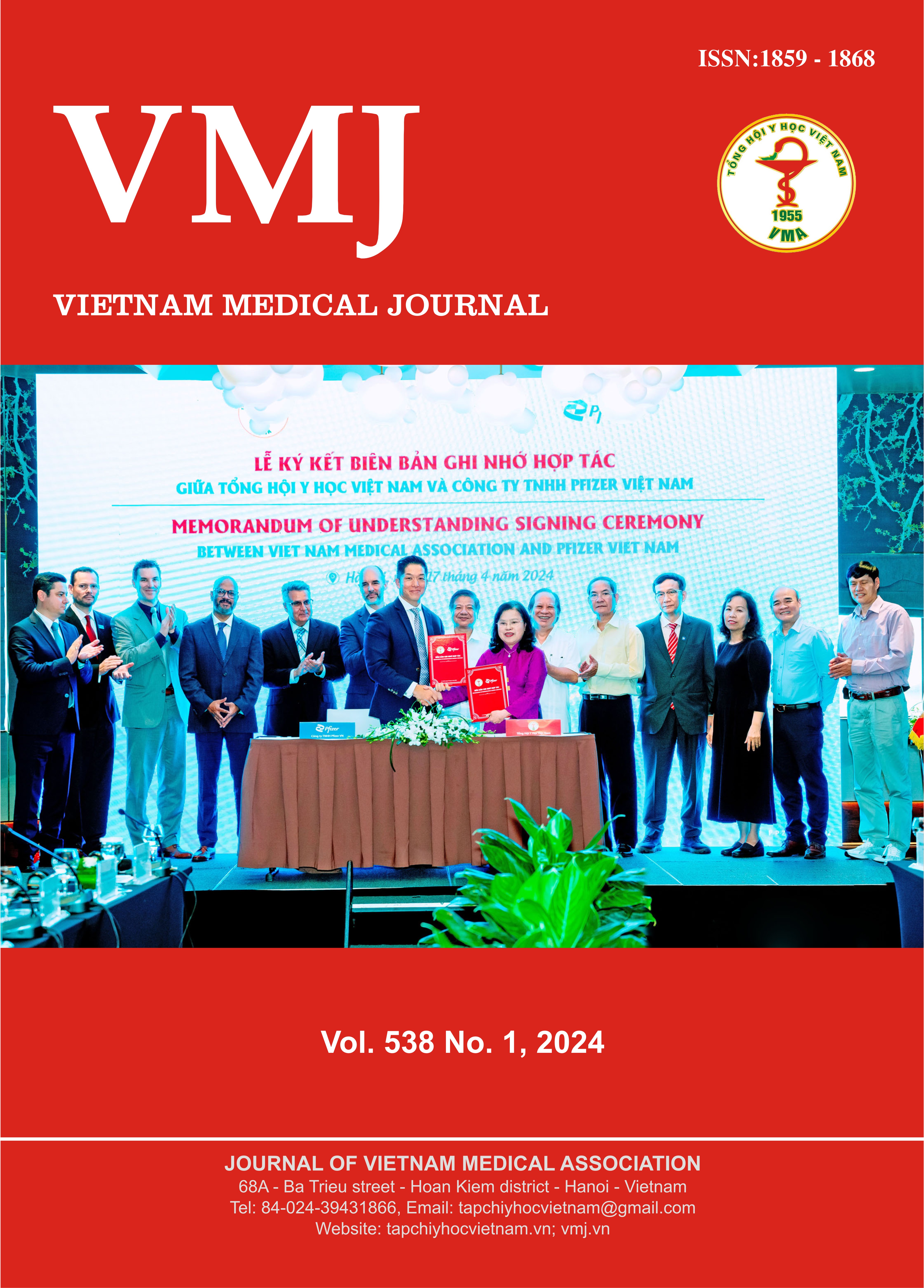ASSESSEMENT IN PERFORMANCE OF LI-RADS ALGORITHM IN DETECTING TREATMENT RESPONSE OF HEPATOCELLULAR CARCINOMA AFTER TRANS-ARTERIAL CHEMOEMBOLIZATION
Nội dung chính của bài viết
Tóm tắt
Background:Trans-arterial hemoembolization (TACE) usually indicated for unresectable hepatocellular carcinoma (HCC) on purpose as a bridging, downstaging or palliative treatment. Liver Imaging Reporting and Data Systems Treatment Response (LR-TR) was created to evaluate each lesion post-TACE, which has localized and is suitable for determining whether the tumor is still viable or Non-viable. Purpose: To assess the completion of LI-RADS version 2018 on computer tomography in the evaluation of HCC after TACE. Materials and Methods: A retrospective cross-sectional study involved 58 patients with hepatocellular carcinoma (HCC) who underwent treatment base TACE from June 2021 – September 2022. The clinical situation, AFP levels, and computer tomography (CT) of the patient after treatment were analyzed. The Radiologist evaluated pre- and post-treatment CT findings using LR-TR category, appropriately. The pooled sensitivity, specificity, and accuracy correclated between LR-TR with standard reference. Results: A total 58 patients with HCC (M/F: 13:1, mean age 56.9±11.0 years). For demonstrating the treatment response after first TACE on CT, Non-viable resulted in 32.8%(19/58), and LR-TR Viable was 67.2%(39/58), sensitivity value of 90% (36/40), specificity value of 83.3% (15/18), positive predictor value of 16.7% (3/18), a negative predictor value of 10% (4/40), accuracy value of 87.9% (51/58). The performance status response- AFP response- imaging response correlation was not statistically different, p= 0.552 and p=0.647. Conclusion: Using LR-TR on CT detects treatment response of HCC post-TACE was useful, and high sensitivity, specificity, and accuracy.
Chi tiết bài viết
Từ khóa
hepatocellular carcinoma, transarterial chemoembolization, Imaging Reporting and Data System treatment response (LR-TR), computer tomography
Tài liệu tham khảo
2. Raoul J-L, Forner A, Bolondi L, Cheung TT, Kloeckner R, de Baere T. Updated use of TACE for hepatocellular carcinoma treatment: How and when to use it based on clinical evidence. Cancer Treatment Reviews. 2019;72:28-36. doi:10.1016/j.ctrv.2018.11.002
3. Chernyak V, Fowler KJ, Kamaya A, et al. Liver Imaging Reporting and Data System (LI-RADS) Version 2018: Imaging of Hepatocellular Carcinoma in At-Risk Patients. Radiology. 2018;289(3):816-830. doi:10.1148/radiol.2018181494
4. Kim SW, Joo I, Kim H-C, et al. LI-RADS treatment response categorization on gadoxetic acid-enhanced MRI: diagnostic performance compared to mRECIST and added value of ancillary features. European Radiology. 2020;30(5):2861-2870. doi:10.1007/s00330-019-06623-9
5. Nguyen H. Research on the clinical and paraclinical characteristics and results of hepatectomy for hepatocellular carcinoma after hepatic artery embolization. . Doctor of Medicine thesis, Hanoi medical university; 2018.
6. Shropshire EL, Chaudhry M, Miller CM, et al. LI-RADS Treatment Response Algorithm: Performance and Diagnostic Accuracy. Radiology. 2019;292(1):226-234. doi:10.1148/radiol.2019182135
7. Huh J, Kim B, Lee JH, et al. Added Value of CT Arterial Subtraction Images in Liver Imaging Reporting and Data System Treatment Response Categorization for Transcatheter Arterial Chemoembolization-Treated Hepatocellular Carcinoma. Investigative Radiology. 2021;56(2):109-116. doi:10.1097/RLI.0000000000000714
8. Kim DW, Choi SH, Lee JS, Kim SY, Lee SJ, Byun JH. Interreader Reliability of Liver Imaging Reporting and Data System Treatment Response: A Systematic Review and Meta-Analysis. Diagnostics (Basel, Switzerland). 2021;11(2):237. doi:10.3390/diagnostics11020237
9. Riaz A, Ryu RK, Kulik LM, et al. Alpha-fetoprotein response after locoregional therapy for hepatocellular carcinoma: oncologic marker of radiologic response, progression, and survival. Journal of Clinical Oncology: Official Journal of the American Society of Clinical Oncology. 2009;27(34):5734-5742. doi:10.1200/JCO.2009.23.1282
10. Bartnik K, Podgórska J, Rosiak G, Korzeniowski K, Rowiński O. Inter-observer agreement using the LI-RADS version 2018 CT treatment response algorithm in patients with hepatocellular carcinoma treated with conventional transarterial chemoembolization. Abdominal Radiology. 2022;47(1):115-122. doi:10.1007/s00261-021-03272-9
11. He C, Peng W, Liu X, Li C, Li X, Wen TF. Post-treatment alpha-fetoprotein response predicts prognosis of patients with hepatocellular carcinoma: A meta-analysis. Medicine (Baltimore). 2019;98(31):e16557. doi:10.1097/MD.0000000000016557
12. Paul SB, Sahu P, Sreenivas V, et al. Prognostic role of serial alpha-fetoprotein levels in hepatocellular carcinoma treated with locoregional therapy. Scand J Gastroenterol. 2019;54(9):1132-1137. doi:10.1080/00365521.2019.1660403
13. Thai DK. Evaluation of Hepatocellular Carcinoma Treatment response by Deb-TACE. Doctor of medicine thesis, 108 Military Central Hospital; 2015.


